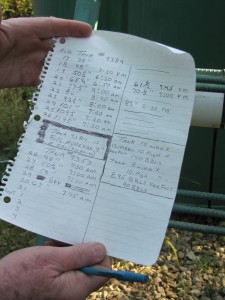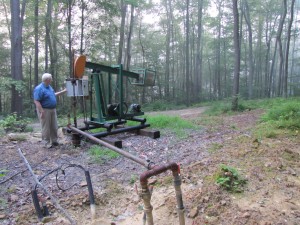On August 30, 2010 I had the opportunity to visit the oil fields of western Pennsylvania. It’s a beautiful area of the country with its green wooded hills. The weather was perfect for a day in the field.
Tom Karg was my guide to several oil fields near Oil City which has a special place in oil industry history. As you can see from the picture, the wells are shallow, but after well over a century of oil production, stripper wells are still busy pumping oil and producing gas.
In the picture, Tom is adjusting his pump-off controller. In our discussions, we looked at several items that could be logged on a daily basis as the pumper visits each well.
 Record keeping happens mainly at the tank battery as shown in the image on the left. The tank levels are simply jotted down by hand on a sheet of paper. When the oil is picked up, the driver records the depth for his records and loads the oil.
Record keeping happens mainly at the tank battery as shown in the image on the left. The tank levels are simply jotted down by hand on a sheet of paper. When the oil is picked up, the driver records the depth for his records and loads the oil.
As far as the well tender or pumper goes, no records are kept. Their job is simply to keep the pumps running. There doesn’t appear to be any effort to optimize production.
Tom’s pump-off controller is installed on a number of wells in the area. With his device, he can actually optimize well production by the use of a timer that will periodically start the pump and run it until it pumps off.
The amount of time needed to reach the pump-off condition (no more fluid left to pump) is recorded on an LCD in the controller and can be read by the pumper. Recording the daily readings can give the operator an idea of the well’s production and can also indicate problems, such as paraffin build-up or holes in the casing.
To get a good idea of daily production there are several pieces of information that could be collected by an iPhone application. The pump-off times of each well and the depth of oil in the tank battery are the main items. Along with each piece of data, we need to be able to identify the date and time of the sample, plus the location of the well.
Since the iPhone already knows the time and date, there is no need for the operator to enter that information. The location can be entered using a well number identification, but since the iPhone has GPS capability it could record the latitude and longitude of each reading.
Tom and I tested the GPS readings from the iPhone at each well. While the readings were indeed different for each well, are they accurate? I’ll do some calculations to verify that over the next few days. The other concern was that in order to get a GPS lock, it might take a few minutes. Would the operator want to wait? The new iPhone 4 has faster GPS performance, so perhaps that will take care of the problem.
Communication was also an important issue. The first item was lack of cell reception in remote areas. Tom had a Verizon phone and my iPhone uses AT&T. Tom generally had better reception, however there were some sites where there was little to no reception for either of us. Tom mentioned that pumpers usually use text messaging rather than voice calls. The text message will generally transmit, even when reception is poor. (By the way, cell reception is independent of the GPS functionality.)
The second communication issue was that there may be more than one pumper tending a particular field. Many times a different person tends the tank battery. This indicates that for a complete picture, data from more than one iPhone is necessary.
Having daily and historical data at the pumper’s fingertips can dramatically improve production. From this point, I need to work on feature and user interface ideas to make the data collection as simple as possible.
Many thanks to Tom Karg for spending time with me. I look forward to visiting other sites.


Recent Comments